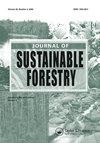西班牙西北部一个严重烧伤地区野火和覆盖后沉积物中的碳损失和植被的封闭
IF 1.8
4区 农林科学
Q3 FORESTRY
引用次数: 1
摘要
摘要许多研究已经评估了覆盖在降低侵蚀风险方面的有效性。然而,尽管它对生态系统恢复有潜在的负面影响,但它对碳损失的影响却很少受到关注。在这项研究中,研究了火灾后前三年西班牙西北部发生严重野火后,秸秆直升机覆盖对土壤侵蚀和沉积物碳损失的影响。火灾发生后的第一年,对照地块的累积平均产沙量为12.4 Mg ha−1,覆盖地块的累计平均产沙率为0.5 Mg ha–1。土壤侵蚀在火灾发生后的第二年急剧减少,在火灾发生的第三年几乎没有。在研究期间,各处理之间未检测到碳浓度的差异。覆盖处理后,由于其在减少沉积物侵蚀方面的有效性,碳损失量显著降低。覆盖处理对植被中固碳量没有显著影响。尽管覆盖物的应用不会影响植被中的碳固定,但它在火灾后的应用可以被认为是管理森林生态系统的一种可持续方式,以减少火灾对碳排放的影响。本文章由计算机程序翻译,如有差异,请以英文原文为准。
Carbon Loss in Sediments and Sequestration in Vegetation after Wildfire and Mulching in a High-Severity Burned Area in NW Spain
ABSTRACT The effectiveness of mulching in reducing the risk of erosion has been evaluated in numerous studies. However, its effect on carbon loss has received less attention, despite the potentially negative effects on ecosystem recovery. In this study, the effects of straw helimulching on soil erosion and carbon loss in sediments were investigated after a severe wildfire in NW Spain during the first three years after fire. During the first year after the fire, the accumulated mean sediment yield was 12.4 Mg ha−1 in the control plots and 0.5 Mg ha−1 in the mulched plots. Soil erosion decreased sharply during the second year after the fire and was almost inexistent during the third year after the fire. No differences in carbon concentration were detected between treatments during the period of study. A significantly lower amount of carbon was lost after the mulching treatment due to its effectiveness in reducing sediment erosion. The mulching treatment did not significantly influence the amount of carbon sequestered in the vegetation. Although the application of mulch did not affect carbon fixation in vegetation, its application after fire can be considered a sustainable way of managing forest ecosystems to reduce the impact of fire on carbon emissions.
求助全文
通过发布文献求助,成功后即可免费获取论文全文。
去求助
来源期刊

Journal of Sustainable Forestry
Social Sciences-Geography, Planning and Development
CiteScore
3.90
自引率
12.50%
发文量
42
期刊介绍:
Journal of Sustainable Forestry publishes peer-reviewed, original research on forest science. While the emphasis is on sustainable use of forest products and services, the journal covers a wide range of topics from the underlying biology and ecology of forests to the social, economic and policy aspects of forestry. Short communications and review papers that provide a clear theoretical, conceptual or methodological contribution to the existing literature are also included in the journal.
Common topics covered in the Journal of Sustainable Forestry include:
• Ecology, management, recreation, restoration and silvicultural systems of all forest types, including urban forests
• All aspects of forest biology, including ecophysiology, entomology, pathology, genetics, tree breeding, and biotechnology
• Wood properties, forest biomass, bioenergy, and carbon sequestration
• Simulation modeling, inventory, quantitative methods, and remote sensing
• Environmental pollution, fire and climate change impacts, and adaptation and mitigation in forests
• Forest engineering, economics, human dimensions, natural resource policy, and planning
Journal of Sustainable Forestry provides an international forum for dialogue between research scientists, forest managers, economists and policy and decision makers who share the common vision of the sustainable use of natural resources.
 求助内容:
求助内容: 应助结果提醒方式:
应助结果提醒方式:


